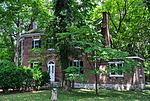James Buchanan House (Nashville, Tennessee)
Houses completed in 1800Houses in Nashville, TennesseeHouses on the National Register of Historic Places in TennesseeMiddle Tennessee Registered Historic Place stubsNational Register of Historic Places in Nashville, Tennessee

The James Buchanan House is a historic log house in Nashville, Tennessee. It was built circa 1800 by James Buchanan, an early Nashville pioneer and signer of the 1789 Cumberland Compact. It's one of the earliest log homes still in existence in the area and is open to the public. The logs were hewn from Tennessee red cedars and nearly-extinct American chestnut trees. The floors were formed from Tennessee poplars and rest on a Tennessee limestone foundation. It has been listed on the National Register of Historic Places since March 29, 1984.
Excerpt from the Wikipedia article James Buchanan House (Nashville, Tennessee) (License: CC BY-SA 3.0, Authors, Images).James Buchanan House (Nashville, Tennessee)
Hurt Drive, Nashville-Davidson Donelson
Geographical coordinates (GPS) Address Nearby Places Show on map
Geographical coordinates (GPS)
| Latitude | Longitude |
|---|---|
| N 36.144722222222 ° | E -86.657222222222 ° |
Address
Hurt Drive 995
37214 Nashville-Davidson, Donelson
Tennessee, United States
Open on Google Maps






